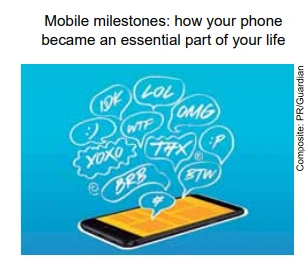Disciplina: Inglês 0 Curtidas
According to the fourth paragraph, a) side-by-side - UNIFESP 2019

Has any device changed our lives as much, and as quickly, as the mobile phone? There are people today for whom the world of address books, street atlases and phone boxes seems very far away, lost in the mists of time. Following, there are just some of the big milestones from the past 30 years that have made almost everything we do easier, more public and very, very fast.
• The first phones arrive – and become status symbols Few people got the chance to use the very early mobile phones. The first call was made in New York in 1973, but handsets with a network to use were not available until 1983 in the US, and 1985 in the UK. That first British mobile phone was essentially a heavy briefcase with a receiver attached by a wire. It cost £2,000 (£5,000 in today’s prices), and gave you half an hour’s chat on an overnight charge. Making a call was not something you could do subtly, but that wasn’t the point; the first handsets were there to be seen. They sent a message that you were bold and confident with new technology, that you were busy and important enough to need a mobile phone, and were rich enough to buy one.
• Text messages spawn a whole new language The first mobiles worked with analogue signals and could only make phone calls, but the digital ones that followed in the early 1990s could send SMS messages as well. After the first message was sent on 3 December 1992, texting took off like a rocket, even though it was still a pretty cumbersome procedure. Handsets with predictive text would make things easier, but in the 1990s you could save a lot of time by removing all excess letters from a message, often the vowels, and so txtspk ws brn. Today the average mobile phone sends more than 100 texts per month.
• Phones turn us all into photographers... There seemed to be no good reason for the first camera phones, which began to appear in 2002, with resolutions of about 0.3 megapixels. They took grainy, blurry pictures on postage stamp-sized screens, and even these filled the phone’s memory in no time. Gradually, though, as the quality improved, the uses followed. As well as the usual photos of friends and family, they were handy for “saving” pieces of paper, and in pubs you could take a picture of the specials board and take it back to your table. Modern camera phones have changed beyond recognition in the past 20 years. The new mobile phones boast the highest resolution dual camera on a smartphone: a 16-megapixel camera and a 20-megapixel camera side-by-side. The dual camera allows users to focus on their subjects, while blurring out the background, producing professional-looking portraits.
…and we turn ourselves into celebrities
Twenty years ago people would have thought you a little strange if you took flattering photos of yourself and your lifestyle and then distributed them to your friends – let alone to members of the public. If you used printed photographs rather than a smartphone app, they would still think so today. Yet sharing our lives on social media is now the norm, not the exception – and it was the camera phone that made it all possible. Now, some phones come with an enormous 64GB of memory, so you can capture, share and store an almost countless number of videos and pictures – well, certainly enough to keep up with the Kardashians.
(www.theguardian.com, 07.07.2017. Adaptado.)
According to the fourth paragraph,
-
side-by-side dual cameras can only be used professionally.
-
camera phones appeared to be pointless at the beginning.
-
initial blurry pictures may be considered creative photography nowadays.
-
the amount of megapixels does not ensure the production of good portraits.
-
it took 20 years for the first camera phone to be engineered.
Solução
Alternativa Correta: B) camera phones appeared to be pointless at the beginning.
A resposta correta é a alternativa b) "camera phones appeared to be pointless at the beginning" porque o trecho do quarto parágrafo menciona que, inicialmente, não havia um motivo claro para a existência dos primeiros celulares com câmera. A frase "There seemed to be no good reason for the first camera phones" indica que, no início, esses dispositivos eram vistos como desnecessários ou sem utilidade aparente, sugerindo que as pessoas não conseguiam enxergar a relevância das câmeras em telefones.
Esse contexto é essencial para entender como a percepção sobre os celulares com câmera mudou ao longo do tempo. Embora os primeiros modelos tivessem resoluções baixas e produzissem fotos de qualidade insatisfatória (descritas como "grainy" e "blurry"), a evolução da tecnologia levou a melhorias significativas nas câmeras dos smartphones. Assim, a frase enfatiza que, apesar de sua aparente falta de propósito inicialmente, os telefones com câmera acabaram se tornando essenciais na vida moderna, transformando a maneira como as pessoas documentam e compartilham suas experiências.
As outras alternativas não refletem corretamente o conteúdo do parágrafo. A alternativa a) sugere que as câmeras só podem ser usadas profissionalmente, o que não é verdade, pois são amplamente utilizadas por amadores. A alternativa c) menciona que fotos borradas poderiam ser consideradas criativas, o que não é abordado no texto. A alternativa d) afirma que a quantidade de megapixels não garante boas fotos, mas não é um foco do parágrafo. Por fim, a alternativa e) afirma que levou 20 anos para o primeiro celular com câmera ser desenvolvido, o que também não é correto, já que o texto menciona que a primeira câmera de celular apareceu em 2002, muito tempo após a invenção do celular.
Institução: UNIFESP
Ano da Prova: 2018
Assuntos: Interpretação Textual em Inglês
Vídeo Sugerido: YouTube